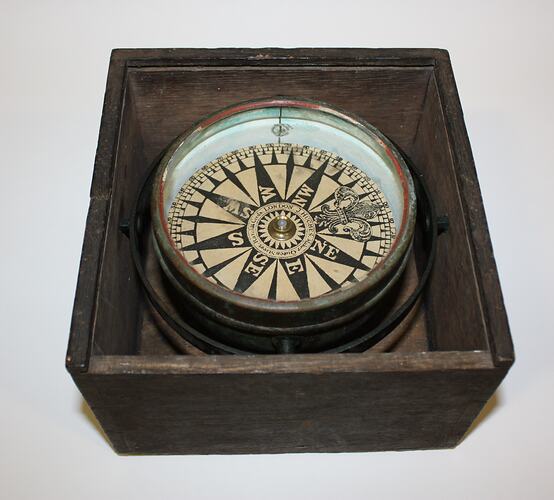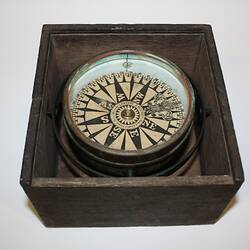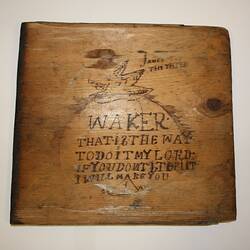Summary
Dry-card lifeboat box compass with a 16-point 'compass rose'. The north mark on the compass has been replaced by a fleur-de-lys. According to the donor the compass is from the 'Cygnet', a wooden schooner built in 1846 and owned by William Blakeley. It sank on 31 August 1876 in Port Phillip Bay in a northerly gale (according to the donors the master was drunk, which precluded an insurance payout on the wreck). It was later advertised for salvage. (A second schooner, the 'Fear Not,' is also linked to William Blakeley. It was wrecked in 1882.)
The compass was probably made in the early 19th century by Joseph Hughes (b. 1781) of 16 Queen Street Radcliffe, London. According to trade directories, a maker of this name and address was trading between 1818 and 1845 (although some of his work may pre-date this) and was succeeded by his son between 1849 and 1878. Other sources suggest his son Henry Hughes (1816-1879) founded Henry Hughes & Sons Ltd in 1838. The company was eventually incorporated in 1903 and continued to produce scientific equipment until the Blitz in 1941 when the shop was destroyed. Following the destruction of the shop a merger was made between the company and Kelvin, Bottomley & Baird Ltd to become Kelvin & Hughes Ltd. The company is still in production today as Kelvin Hughes Ltd. As the compass bears Joseph's name, rather than Henry's, it seems safe to assume that it was made sometime before the founding of Henry Hughes & Sons, thereby predating the Cygnet by at least a decade.
The lid of the box containing the compass has been inscribed with the words 'James the Third' and a short poem. Two crudely drawn images, one of a starfish and the other of a small sailing vessel, have also been carved onto the lid. The starfish is commonly used as a symbol of the Virgin Mary, the 'Stella Maris.' The Stella Maris is also referred to as the 'Star of the Sea' and is used by sailors to gain the Virgin's protection whilst at sea.
James III of England (and James VIII of Scotland) is known as the 'Old Pretender' to the English throne following the abdication of his Catholic father, James II, in favour of his Protestant half-sister Mary II and her husband William III. James never officially reigned in England and his claims passed to his son, Charles Edward Stuart (Charles III or the 'Young Pretender'), more commonly known as 'Bonnie Prince Charlie.' The Jacobite cause to restore the Stuart King James II of England and his heirs to the thrones of England, Scotland and Ireland largely died with his second son Henry Benedict Stuart in 1807. The starfish - a secret symbol of the Jacobites, according to the Culloden Guidebook (produced by the National Trust UK) - reinforces the link to Jacobite sympathisers.
The meaning of the poem remains unclear.
Part of a collection of and other material relating to the life of William Henry Blakeley and the Blakeley family donated to Museum Victoria. William Blakeley was the first saw manufacturer in Australia. He was born in England in 1839 and was indentured as a saw maker. In 1867 he set up his own saw shop in Little Bourke Street - soon to become a successful manufacturing business, W.H. Blakeley and Co (which became W.H. and Company Proprietary Limited in 1922), with several locations in inner Melbourne. The Blakeley business has continued into the 21st century. The donor and her sisters are the daughters of William and Annie's son William Gillott Blakeley and his wife Ada Henrietta Gibson.
Physical Description
Ship's compass enclosed in a wooden box with sliding lid. The lid has a carved inscription as well as an image of a sailing ship and a starfish. The compass is 135 mm in diameter and has a large 16-point rose, surrounded by smaller navigational points. The north point is a fleur-de-lis.
Significance
Statement of Significance
This object is significant for both its link to the 'Cygnet' and its inscription relating to 'James the Third', suggesting that it is in some way linked to Jacobitism - the political movement to restore the Stuart King James II of England and his heirs to the thrones of England, Scotland and Ireland.
James III of England (and James VIII of Scotland) was known as the 'Old Pretender' to the English throne following the abdication of his Catholic father, James II, in favour of his Protestant half-sister Mary II and her husband William III. James never officially reigned in England and his claims passed to his son, Charles Edward Stuart (Charles III or the 'Young Pretender'), more commonly known as Bonnie Prince Charlie.
The Jacobite cause (the political movement to restore the Stuart King James II of England and his heirs to the thrones of England, Scotland and Ireland) appears to have died with his second son Henry Benedict Stuart in 1807 (however, as Henry does not appear to have pressed his claim the Jacobite cause more rightly ended with his brother's death in 1766).
The link to the Jacobite cause on the compass is reinforced by the starfish - a secret symbol of the Jacobites, according to the Culloden Guidebook (produced by the National Trust UK).
As the 'Cygnet' existed only from 1846 to 1876, however, the Jacobite theory would only be plausible if either the compass pre-dated the 'Cygnet' (which is a possibility) or the remnants of the Jacobite cause were still sufficiently active to record a subversive message. In fact, despite the traditional end of Jacobitism being either the Battle of Culloden (1746) or the death of Henry Benedict Stuart in 1807 (the younger brother of 'Bonnie Prince Charlie') Jacobitism appears to have continued, even until the present day, albeit in a more passive capacity. Occasionally referred to as 'Legitimism,' the Jacobite movement upholds the rights of the elder branch of the House of Stuart to rule the United Kingdom but are loyal to the crown as long as the 'legitimate' monarchs remain content to not press their claims. Evidence for the Jacobite movement in Australia can be found in newspaper articles which provide details of the activities of Australian Highland Socities and 'Scottish Nationalists' as well as those of the 'Australian Jacobite' Theodore Napier. It is also interesting to note in 'The Jacobites' author Frank McLynn mentions that Arthur Phillip, first governor of New South Wales, had to swear that he would not attempt to restore Charles Edward Stuart, or his successors, to the throne.
There also remains the possibility that 'James the Third' refers to a vessel rather than an individual, but in that case the use of the name is still a controversial one. Following the Battle of Culloden in 1746 several 'disarming acts' were passed by the British Parliament that outlawed much of traditional Scottish culture - acts that were not repealed until 1782 and not entirely laid to rest until the royal visit of 1822. In this context the use of the name 'James the Third' for a vessel, even so many years after the traditional end of Jacobite rebellion, would be ambiguous (as it could equally refer to the medieval Scottish king) and potentially subversive as an assertion of Scottish patriotism.
There is no evidence to suggest that either William Blakeley, or his family, were involved in the Jacobite movement, but it is not known if Blakeley was the original owner of the compass.
More Information
-
Collecting Areas
-
Acquisition Information
Donation from Helen Blakeley, 23 Aug 2012
-
Maker (Probable)
-
Maker (Possible)
Henry Hughes & Son Ltd, London, England, Great Britain, 1838-1846
-
Original Owner
-
Ship Named
-
Inscriptions
Hand-carved into the lid of the compass box: 'James / THE THIRD / WAKER / THAT IS THE WAY / TO DO IT MY LORD / IF YOU DONT STOP IIT[sic] / I WILL MAKE YOU' Inscribed on the compass, around the central point: 'J. HUGHES, Maker, Queen Street, Radcliffe Crofs (?), LONDON'
-
Classification
Water transport, Ship fittings & auxiliaries, Marine instruments
-
Category
-
Discipline
-
Type of item
-
Overall Dimensions
196 mm (Width), 138 mm (Height)
-
Other Dimensions
192 mm (Width), 189 mm (Height)
Lid Measurements
-
References
'Cygnet,' Wrecksite, at: [Link 1] accessed: January 23, 2013 'Cygnet,' Victorian Heritage Database, at: [Link 2] accessed: January 23, 2013 'Fear Not,' Australian National Shipwreck Database, at: [Link 3] accessed: February 13, 2013 'Kelvin Hughes: The Hughes Connection,' Wikipedia, at: [Link 4] accessed: January 30, 2013 Internet discussion thread, on Sword Forum International, referencing the five-pointed star and the Culloden Guidebook: [Link 5] accessed: January 30, 2013 'Jacobite Kings & Their Heirs,' Jacobite Heritage, at: [Link 6] accessed: January 30, 2013 John Anthony Leckey, 'Low, Degraded Broots? Industry and entrepreneurialism in Melbourne's Little Lon, 1860-1950,' PhD Thesis for the Department of History, University of Melbourne, April 2003 Frank McLynn, 'The Jacobites,' Routledge & Kegan Paul Ltd. (London), 1988, p.2 'The Rehabilitation of Scottish Jacobitism,' Colin Kidd, The Scottish Historical Review , Vol. 77, No. 203, Part 1 (Apr., 1998), pp. 58-76, Published by: Edinburgh University Press, Article Stable URL: [Link 7] 'Legitimism in England,' by Melville Henry Massue, Marquis de Ruvigny et Raineval, and Cranstoun Metcalfe, first appeared in the September 1897 issue of The Nineteenth Century Review, reproduced on 'Jacobite Heritage' at: [Link 8] accessed: February 6, 2013 'Jacobitism in Scotland: Episodic Cause or National Movement?' Allan I. Macinnes, The Scottish Historical Review , Vol. 86, No. 222, Part 2 (Oct., 2007), pp. 225-252, Published by: Edinburgh University Press, Article Stable URL: [Link 9] Magnus Magnusson, 'Scotland: The Story of a Nation,' Harper Collins (London), 2000 Information about Henry Hughes drawn from trade directories provided by Richard Dunn, National Maritime Museum, Grenwich, 27 Feb 2013
-
Keywords
Compasses, Ships, Ship Accessories, Navigation, Water Transport, Jacobites





